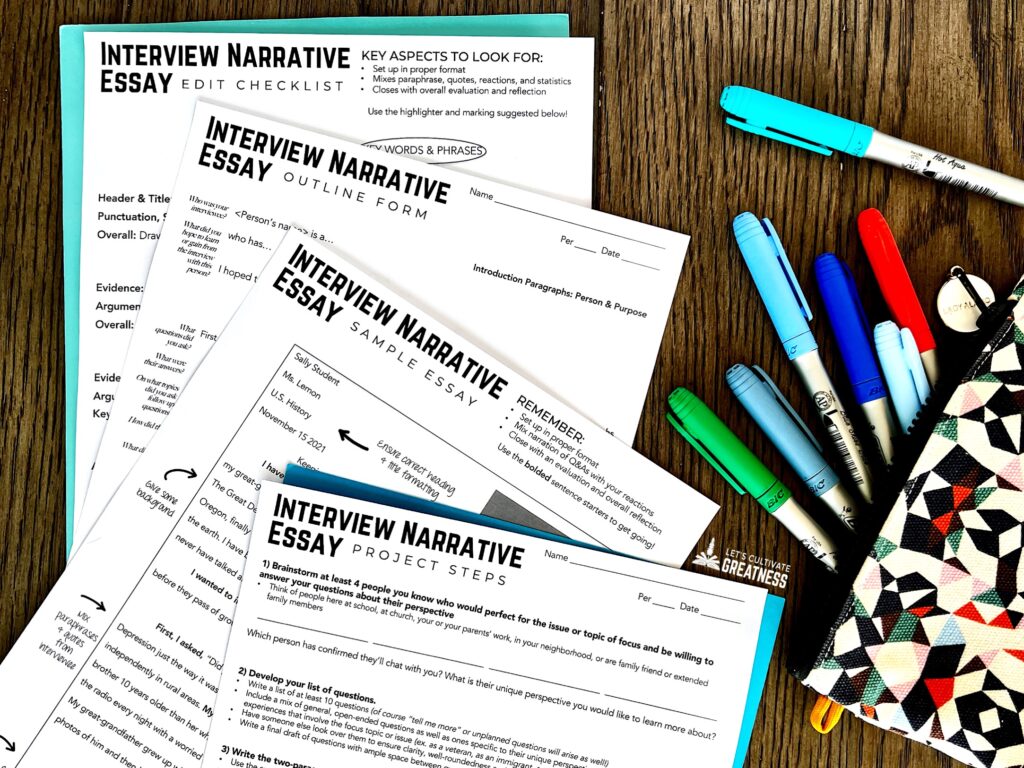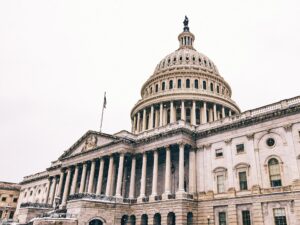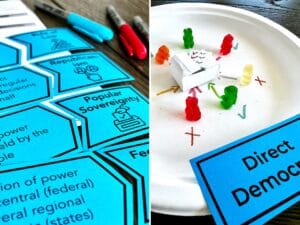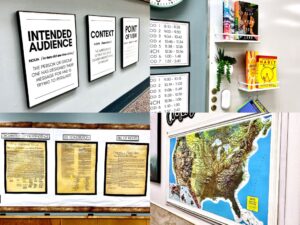Adding in more project-style inquiry learning is equal parts exciting and overwhelming. And creates a lot of questions.
However, if you carefully select a project you know will hit meaningfully and create firm scaffolds to support your students, the rewards are worth the effort.
The most important thing to know is that you don’t have to upend your whole curriculum. In fact, some of the best projects are the most universal, meaning they can go with almost any unit. My favorite one is this oral history or community member interview project.
If you want to dive more into creating a full project-based curriculum, head over to my How-To Guide for Setting Up a PBL Social Studies Classroom blog post for answers to all your questions. Then head back here to get set up with this perfect starter project!
I like this interview project so much that I used it in both my US History and Civics classes. The topics are different, and the skills of confidently reaching out to speak with an adult and engaging in deep listening are so essential that I feel it’s worth doing twice.

In US History for our Immigration unit, my students pick an immigrant they know in their life. We define that term liberally to include second-generation Americans or even those who have moved to our town from other regions of our country.
Even in my small, generations-deep community students finding someone to interview has never been a challenge.
And in Civics for our 3 Branches of Government unit, my students pick someone with a unique perspective on how our government operates. This could be anyone—a government employee, a member of the military, a person who has spent time in jail, or even a self-proclaimed “news junky.”
These topics have many options for students to select the best person they know, and I love seeing the interesting perspectives they seek out.
Students then prepare for, conduct, and write a narrative essay about their conversation with their interviewee. Creating an authentic product with an authentic audience is a cornerstone of PBL.
This interview project pairs well with almost any social studies unit topic, making it a perfect starter PBL for you to teach.
Civil War unit? Interview a veteran. Constitutional Rights unit? Interview someone about their thoughts on the First Amendment. Industrial Revolution unit? Interview a parent or grandparent about technology changes since they were teenagers.
Once you know which unit this project best fits with, the rest is easy. Here are the six basic steps.
Hook Students With a Story
One key best practice for projects is to model it for your students. In this case, I hook in my students by opening class with a story. And I don’t even explain why I’m telling it.
I share with my Civics students a story rich with detail about how my neighbor, a Vietnam War veteran, developed his unique view of democracy one day as the naval ship’s entire mission was stalled until he could fix the radar antenna atop the cruiser.
He told me how he realized, precariously perched high above the crew, that “democracy yields to the mission, not the leader.” In that humble moment, his task was the most important one on the ship.
What a cool and novel perspective on the concept, huh?
My students have no idea why I’m sharing this story, and it’s almost because it seems so off-topic that they are leaning into it. I end by revealing that they will conduct a similar interview, asking their chosen person about their thoughts on democracy and our government.
Brainstorm Interviewees
Provide criteria of who will make a good candidate for an interviewee. For my US History students, that means communicating that a looser standard of an “immigrant” is totally acceptable: a person from a different part of the country or a second-generation American.
Also, review who wouldn’t make good candidates. Usually, parents or classmates are off limits since one of the soft skills I’m teaching students is speaking comfortably with adults they don’t know well, which research has shown is practiced less frequently in lower-income homes.
Give students time at this step to consider a handful of people. That way, they don’t stop at the first person they think of but instead, pick the best out of multiple options. Plus, it gives them backups if their top choice doesn’t work.
Develop Questions & Conduct Interview
Next, provide students with sample questions and question stems for them to tailor to their interviewee. I show how I asked questions specific to my person (How did you end up serving in the military?) and customized generic questions for him (How did serving in an unpopular war shape your view of democracy?)
This is also the time to reinforce what the goals of the interview are.
For example, I want my US History students to hear about the struggles, hopes, and noticings of someone who left their home and had to assimilate somewhere new. My community has strong multigenerational roots, so this project is even more valuable. I really want them to have a face-to-face conversation with someone who hasn’t always lived in their town. So, I explicating say that to them.
Also, you’ll want to set a firm deadline for students to conduct their interview— a week to two after crafting the questions is good.
Write Narrative Essay
Again, you’ll want to model your narrative write-up (or at least portions of one) with students and provide sentence stems for organizing paragraphs, exact quotes and interviewee paraphrasing, and personal reflections from their experience.
This isn’t a writing style they have likely done before, so models and dedicated class time will be essential and greatly impact their writing quality!
Write Thank You & Share with Interviewee
The most important step! Grab some blank note cards and teach the old-fashion art of the handwritten thank you card. Then, have your students deliver a copy of their narrative essay and card to their interviewee.
If you grab my Interview Narrative Essay Project, how-to directions for writing them are included!

This is one of my favorite projects, big or small, each year. I see my students grow as young adults and writers, becoming more empathetic and aware of the stories we all carry with us. Get your own step-by-step, fully scaffolded Interview Narrative Essay Project Kit and start making authentic learning.
Feature image credit: Alejandro Escamilla





